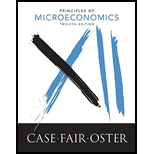
Principles Of Microeconomics (book With Myeconlab With Pearson Etext Access Card)
12th Edition
ISBN: 9780134435039
Author: CASE, Karl E.; Fair, Ray C.; Oster, Sharon E.
Publisher: PEARSON
expand_more
expand_more
format_list_bulleted
Question
Chapter 19, Problem 6.2P
To determine
Identify the concept of voting paradox.
Expert Solution & Answer
Want to see the full answer?
Check out a sample textbook solution
Students have asked these similar questions
Does traditional one-person-one-vote (1p1v) majority voting allow voters to directly express differences in strengths of preference? Does quadratic voting do any better? Discuss the differences and then explain which system you prefer, and why.
Please no written by hand
"No voting system is perfect." What does it mean by economist K. Arrow? Give a brief account on Condorcet Voting Paradox. A public school district is voting on the school budget and the resulting student-teacher ratio. A poll finds that 20 percent of the voters want a ratio of 9:1, 25 percent want a ratio of 10:1, 15 percent want a ratio of 11:1, and 40 percent want a ratio of 12:1. What outcome would you expect the district to
Assume there are three voters: A, B and C. Voter preferences can be ranked along a left-to-right spectrum that ranges from 1-9; 1 being the most left leaning preference and 9 being the most right leaning preference. Suppose these voters will choose between candidates Smith and Jones in an upcoming election. Assuming the following voter preferences:
True/False Explain: If the median voter theorem holds, candidates Smith and Jones will either both adopt preference 5 OR one will adopt preference 4 while the other adopts preference 6.
B. Suppose the electorate becomes more polarized; A moves from 4 to 1 while C moves from 6 to 9. B remains at 4. How does the median voter model predict candidates Smith and Jones will change their preference?
C. Keeping the assumptions from B, how does the election result change if a tax on non-voters doubles the number of voters while preserving the distribution of preferences?
D. If the tax in C induces 100% compliance (everyone votes), did this tax…
Chapter 19 Solutions
Principles Of Microeconomics (book With Myeconlab With Pearson Etext Access Card)
Knowledge Booster
Similar questions
- Answer to Part CAssume there are three voters: A, B and C. Voter preferences can be ranked along a left-to-right spectrum that ranges from 1-9; 1 being the most left leaning preference and 9 being the most right leaning preference. Suppose these voters will choose between candidates Smith and Jonesin an upcoming election.Assuming the following voter preferences:Voter ID Preference (1-9)A 4B 5C 6B. Suppose the electorate becomes more polarized; A moves from 4 to 1 while C moves from 6 to 9. B remains at 5. How does the median voter model predict candidates Smith and Jones will change their preference? C. Keeping the assumptions from B, how does the election result change if a tax on non-voters doubles the number of voters while preserving the distribution of preferences?arrow_forwardSuppose that friends Jennifer, Stephanie, and Megan cannot agree on how much to spend for a bouquet of flowers to send to a person who allowed them to use her beach house for the weekend. Jennifer wants to buy a moderately priced bouquet, Stephanie wants to buy an expensive bouquet, and Megan wants to buy a very expensive bouquet. Assuming no paradox of voting, majority voting will result in the decision to buy Multiple Choice an inexpensive bouquet. a very expensive bouquet. a moderately priced bouquet. an expensive bouquet. Barrow_forwardExplain the paradox of voting through reference to the accompanying table, which shows the ranking of three public goods by voters Jay, Dave, and Conan:arrow_forward
Recommended textbooks for you

 Economics (MindTap Course List)EconomicsISBN:9781337617383Author:Roger A. ArnoldPublisher:Cengage Learning
Economics (MindTap Course List)EconomicsISBN:9781337617383Author:Roger A. ArnoldPublisher:Cengage Learning
 Principles of Microeconomics (MindTap Course List)EconomicsISBN:9781305971493Author:N. Gregory MankiwPublisher:Cengage Learning
Principles of Microeconomics (MindTap Course List)EconomicsISBN:9781305971493Author:N. Gregory MankiwPublisher:Cengage Learning Principles of Economics (MindTap Course List)EconomicsISBN:9781305585126Author:N. Gregory MankiwPublisher:Cengage Learning
Principles of Economics (MindTap Course List)EconomicsISBN:9781305585126Author:N. Gregory MankiwPublisher:Cengage Learning Principles of Economics, 7th Edition (MindTap Cou...EconomicsISBN:9781285165875Author:N. Gregory MankiwPublisher:Cengage Learning
Principles of Economics, 7th Edition (MindTap Cou...EconomicsISBN:9781285165875Author:N. Gregory MankiwPublisher:Cengage Learning


Economics (MindTap Course List)
Economics
ISBN:9781337617383
Author:Roger A. Arnold
Publisher:Cengage Learning


Principles of Microeconomics (MindTap Course List)
Economics
ISBN:9781305971493
Author:N. Gregory Mankiw
Publisher:Cengage Learning

Principles of Economics (MindTap Course List)
Economics
ISBN:9781305585126
Author:N. Gregory Mankiw
Publisher:Cengage Learning

Principles of Economics, 7th Edition (MindTap Cou...
Economics
ISBN:9781285165875
Author:N. Gregory Mankiw
Publisher:Cengage Learning